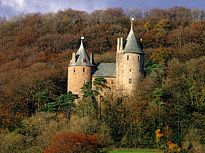Castell Coch
Some five miles to the north of Cardiff stands the extraordinary Castell Coch or 'Red Castle', the ultimate fairytale castle. Clinging dramatically to a wooded hillside above the valley of the river Taff, this castle was originally built in the late 13th century by Gilbert De Clare, Earl of Gloucester to command a narrow gap of the river Taff and the plain of Cardiff. The initial castle was destroyed sometime in the 15th century and left as a ruin for almost 400 years.

On the foundations of this early castle the 3rd Marquis of Bute commissioned William Burgess to fabricate a 13th century castle. Lord Bute, who owned Cardiff's booming docklands and was reputedly the wealthiest man in the world, gave the eccentric genius Billy Burgess free rein to create a Victorian dream of the Middle Ages. It was to be a companion piece to the Marquis's main home at Cardiff Castle. Burgess died suddenly in 1881 before his work was finished but his work was completed by colleagues who remained faithful to a unique vision, which although extravagant, was underpinned by a profound knowledge of medieval architecture.
The castle was built with two round towers which rise out of buttressed square bases and a third tower that stands in a dry moat crossed by a wooden bridge. Burgess allowed personal taste to enter his design and added conical turrets to the towers instead of the traditional flat roof, parapet and rampart. As a result Castell Coch appears more like a French chateau than a Welsh castle. The towers and walls surround a central courtyard.
The castle was protected against visitors by a drawbridge and portcullis. Being small the castle was not built as a permanent residence and was only intended for occasional use in the summer. The main rooms are arranged around the central courtyard and consist of a banqueting hall, drawing room, two bedrooms, servants' hall and kitchen. The rooms are elaborately decorated with a riot of colour and minute detail. The main theme seems to be taken from medieval illuminations. The octagonal, high vaulted room on the first and second floors is illustrated with Aesop's Fables. The whole effect is of breath-taking gaudiness that is undoubtedly Victorian.